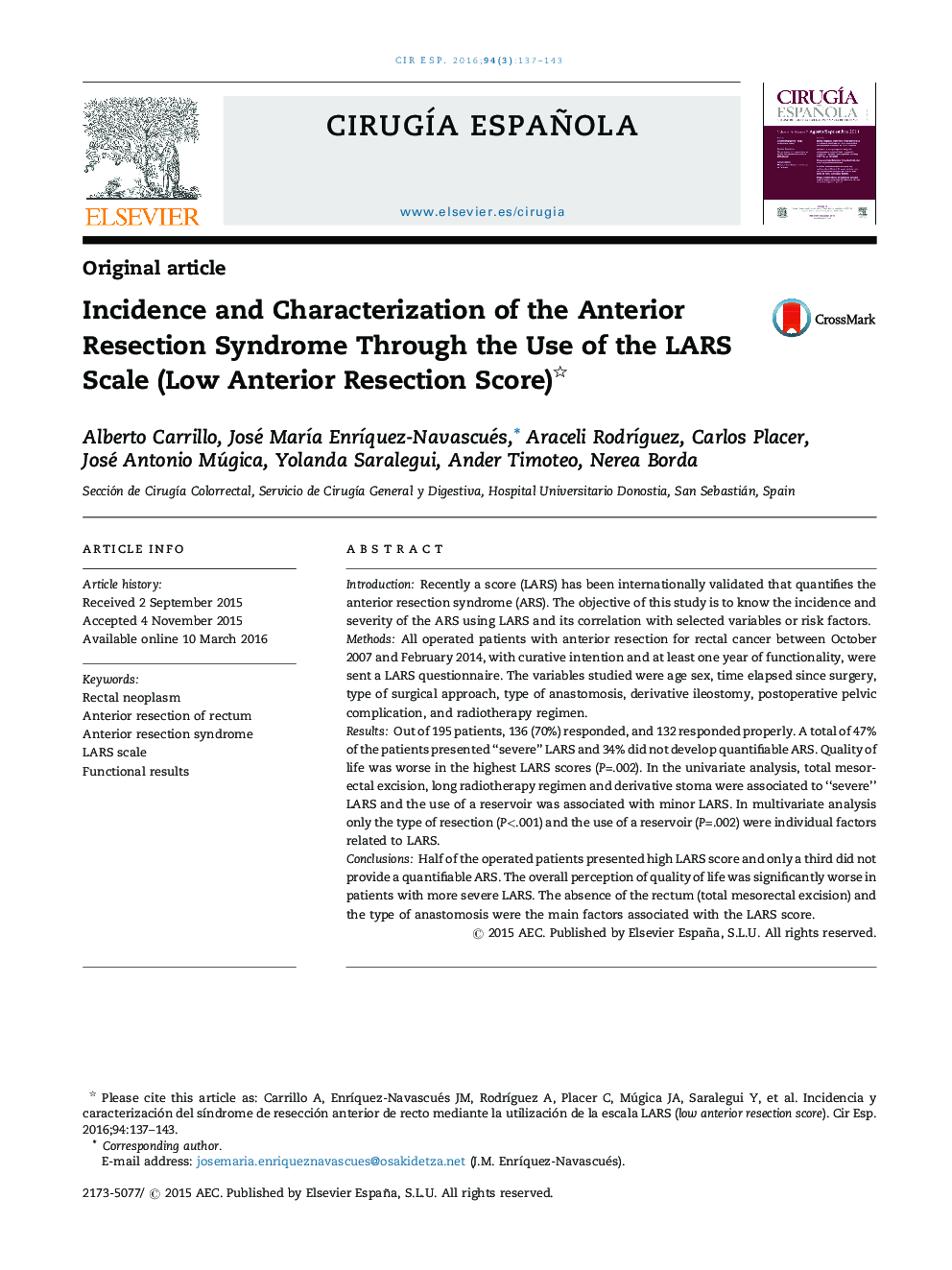| کد مقاله | کد نشریه | سال انتشار | مقاله انگلیسی | نسخه تمام متن |
|---|---|---|---|---|
| 4254508 | 1284382 | 2016 | 7 صفحه PDF | دانلود رایگان |

IntroductionRecently a score (LARS) has been internationally validated that quantifies the anterior resection syndrome (ARS). The objective of this study is to know the incidence and severity of the ARS using LARS and its correlation with selected variables or risk factors.MethodsAll operated patients with anterior resection for rectal cancer between October 2007 and February 2014, with curative intention and at least one year of functionality, were sent a LARS questionnaire. The variables studied were age sex, time elapsed since surgery, type of surgical approach, type of anastomosis, derivative ileostomy, postoperative pelvic complication, and radiotherapy regimen.ResultsOut of 195 patients, 136 (70%) responded, and 132 responded properly. A total of 47% of the patients presented “severe” LARS and 34% did not develop quantifiable ARS. Quality of life was worse in the highest LARS scores (P=.002). In the univariate analysis, total mesorectal excision, long radiotherapy regimen and derivative stoma were associated to “severe” LARS and the use of a reservoir was associated with minor LARS. In multivariate analysis only the type of resection (P<.001) and the use of a reservoir (P=.002) were individual factors related to LARS.ConclusionsHalf of the operated patients presented high LARS score and only a third did not provide a quantifiable ARS. The overall perception of quality of life was significantly worse in patients with more severe LARS. The absence of the rectum (total mesorectal excision) and the type of anastomosis were the main factors associated with the LARS score.
ResumenIntroducciónRecientemente se ha validado una escala internacional de puntuación (LARS) que cuantifica el síndrome de resección anterior (SRA). El objetivo de este estudio es conocer la incidencia y gravedad del SRA utilizando el LARS y su relación con variables seleccionadas.MétodosA todos los pacientes con resección anterior por cáncer de recto operados entre octubre de 2007 y febrero de 2014, con intención curativa y con más de un año de funcionalidad, se les envió el cuestionario LARS. Las variables estudiadas fueron: edad, sexo, tiempo transcurrido desde la cirugía, tipo de resección, vía quirúrgica, tipo de anastomosis, realización de estoma derivativo, complicación postoperatoria y régimen de radioterapia.ResultadosDe 195 pacientes, 136 (70%) respondieron (132 adecuadamente). El 47% de los pacientes presentaba un LARS mayor y el 34% no desarrolló SRA cuantificable. Se relacionó un LARS mayor con peor calidad de vida (p = 0,002). En el análisis univariante, la escisión mesorrectal total (ETM), la radioterapia larga y el estoma derivativo se asociaron a un LARS mayor, y la utilización de un reservorio, a uno menor. En el análisis multivariante solo el tipo de resección (p < 0,001) y la utilización de reservorio (p = 0,002) fueron factores individuales relacionados con el LARS.ConclusionesLa mitad de los pacientes operados presentaron un LARS mayor y solo un tercio no presentó un SRA cuantificable. La percepción global de la calidad de vida fue significativamente peor en los pacientes con LARS mayor. La ausencia de recto (ETM) y la forma de reconstrucción anastomótica fueron los principales factores asociados a la puntuación LARS.
Journal: Cirugía Española (English Edition) - Volume 94, Issue 3, March 2016, Pages 137–143